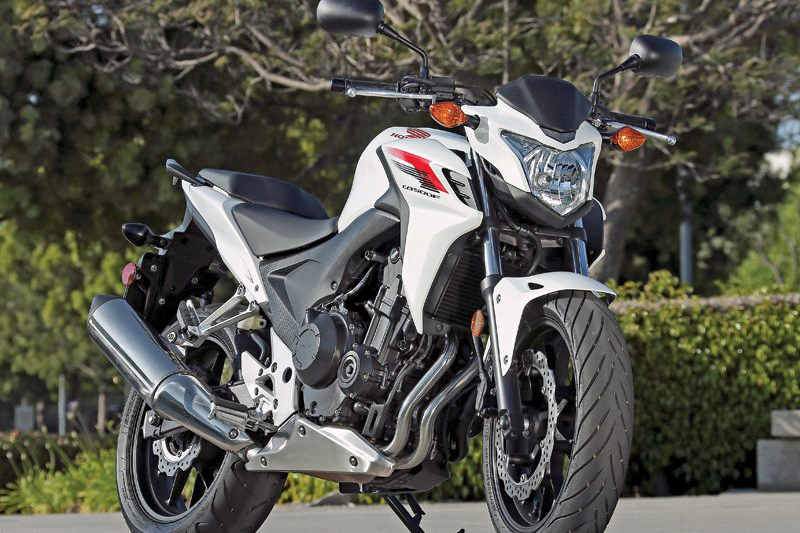2013 Honda CB500F and CBR500R

First Ride Review
After several years of downturn-induced dormancy, Honda has released 22 new or significantly updated models since 2012—more bikes than some manufacturers have in their entire lineup. Honda builds and sells millions of two-wheelers every year, the vast majority of which are small-displacement runabouts sold in places like India and China. What enables Honda to bring a bumper crop of new bikes into the U.S. is its recent focus on “global” models—motorcycles that are designed not for specific markets but for the entire world. Whenever possible, they share components and are built in Thailand where labor costs are low.
Perhaps the best example of a global model—or models—is Honda’s trio of all-new 2013 CB500s, which share the same engine, transmission, chassis and many other components—and yes, they’re made in Thailand. With prices starting below $6,000, the naked CB500F, sporty CBR500R and adventuresome CB500X give budget-conscious riders three styles to choose from. And it is no accident that, when a CB500 owner is ready to trade up, there are larger counterpart models already in Honda’s lineup: the CB1000R, CBR600RR/CBR1000RR and NC700X, respectively.
Two of the three—the CB500F and CBR500R—are identical except for the fairing and the handlebar. The CB500F has small fairing shrouds in front of the tank, a minimalist headlight fairing and a tubular handlebar, whereas the CBR500R has full bodywork and clip-ons. I rode both models at Honda’s press launch, and we’ve been putting miles on a CB500F in the weeks since. The rugged-looking CB500X, which has a wider handlebar, more front suspension travel, a taller seat height, a manually adjustable windscreen and more fuel capacity, will be released later this year.
Beyond affordability, the CB500s are designed to be lightweight, comfortable and easy to ride. With its 4.1-gallon tank full, the CB500F tips the scales at just 419 pounds (claimed wet weight for the CBR500R is 425 pounds), and the CB500F and CBR500R have the same firm, 30.9-inch-high seat. The CBR500R’s lower clip-ons put a bit more weight on your wrists and bend in your back, yet both models are roomy enough for all but the tallest riders. The footpegs are at a sensible height and the bikes have a slim, compact feel. Of course, in this price range, you’ll have to forego adjustable levers and seat height, and the only suspension adjustment is rear preload.
There’s nothing threatening about the CB’s liquid-cooled, fuel-injected 471cc parallel twin, but I wouldn’t go so far as calling it dull. With a nearly square bore and stroke (67.0 x 66.8mm), a 180-degree crank and DOHC with four valves per cylinder, the engine was designed for efficiency and smooth power delivery. Like clockwork, horsepower climbs steadily upwards from 15 at 3,000 rpm to a peak of 45.5 at 8,500 rpm, while the torque curve is nearly flat, ranging from 25-31 lb-ft over the rev range. Honda’s tried-and-true Programmed Fuel Injection provides crisp fueling and throttle response is spot-on. A counterbalancer quells most unwanted vibration, though some high-frequency buzz can be felt through the grips and tank. The cable-actuated clutch has a light pull, the 6-speed transmission shifts easily and the 2-into-1 stainless steel muffler emits a friendly burble. No rough edges, no unnecessary complexity.
What makes small, lightweight bikes like the CB500F and CBR500R so fun to ride is their gazelle-like agility. Short 55.5-inch wheelbases, quick-steering geometry and narrow, grippy Dunlop Sportmax tires help them negotiate tight corners with ease yet they don’t feel twitchy—a characteristic that would make new riders nervous. Though smaller than most bikes on the road, they feel solid, thanks in part to a rigid tubular-steel frame that uses the engine as a stressed member. The biggest weakness, at least from a performance standpoint, is the suspension and brakes. Though adequate given the price and intent of these bikes, these are the components where the greatest cost savings can be realized and therefore are very basic. At moderate speeds and on smooth roads, all is well, but when pushed hard or the pavement gets rough, not so much. The suspension is undersprung and underdamped (at least with my 200-pound sack of potatoes in the saddle), and the dual-disc brakes with pin-slide calipers offer limited stopping power. Honda says that the petal-type discs improve heat dissipation and reduce unsprung weight, but they also allow Honda to further reduce costs: the rear 240mm disc fits inside the front 320mm disc and both were stamped from the same metal plate. For only $500, ABS can be added to any of the three CB500 models.
Although frills are few, the Honda CB500F and CBR500R have the basics covered. A blue-tinted digital instrument panel includes a speedometer, tachometer, odometer, dual tripmeters, fuel gauge, clock, and real-time and average fuel consumption. The two-piece seat includes a decent-sized pillion with large grab handles, the metal fuel tank accommodates a magnetic tankbag and a wire-cable helmet lock is included under the seat.
Of the two, the CB500F is the way to go. It costs $500 less than the CBR500R, has less plastic to damage in a tipover and the taller handlebar allows a more head-up riding position. Spend that $500 on ABS for a larger safety margin. With its tiny headlight fairing, the CB500F offers almost no wind protection, and a windscreen isn’t on Honda’s accessory list (but saddlebags, a top trunk, a luggage rack, cowlings and other items are). But it sips gas and is a total blast to ride.
